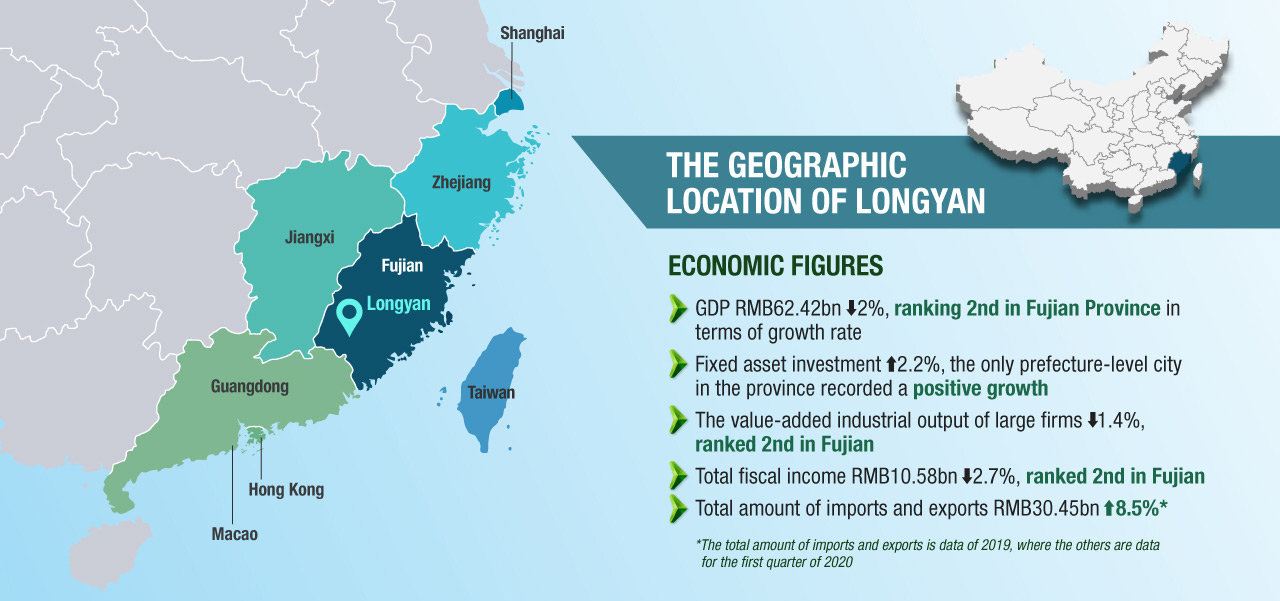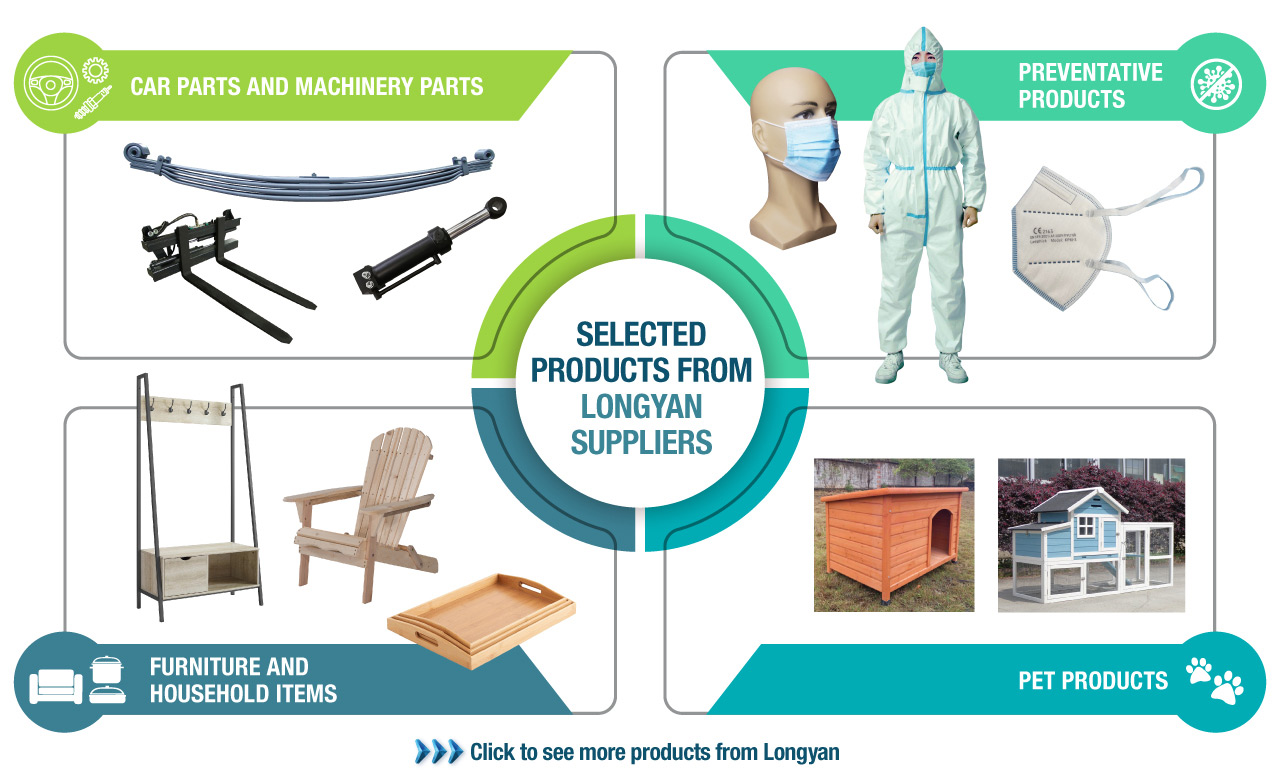Leveraging the Belt and Road Initiative, Longyan is set to thrive with its comprehensive transportation links, diversified industrial bases and traditional and hi-tech industries
Longyan is a prefecture-level city in the western part of Fujian Province in Mainland China. Lying at the intersection of Fujian, Guangdong and Jiangxi provinces, it covers an area of 19,000 square kilometres and has a population of 3.18 million. It is an ancestral home of the Hakka people and the hometown of many overseas Chinese people, as well as a national-level Hakka cultural and ecosystem conservation experimental zone. The zone comprises of Changting County and the Ting River, which are known as the “Capital of Hakka” and “Hakka’s Mother River”, respectively. Five of the city’s seven counties are primarily made up of Hakka people, who account for more than 75 per cent of the entire population in Longyan.
Pleasant environment
Named as a national civilised city, national garden city and national forest city, Longyan is surrounded by a bountiful natural environment and has a forest coverage rate of 78.9 per cent, ranking first in Fujian Province and among the highest in the country. It is situated in the upper sections of the three major rivers in the province, the Min River, Jiulong River and Ting River, all of which meet Grades I to III water quality standards. Sitting at an average altitude of 460 metres, the city enjoys a favourable climate and has the highest number of good air quality days in Fujian.
Efficient transportation networks and strong industrial bases
Longyan is a transportation hub advantageously positioned in the border area among Fujian, Guangdong and Jiangxi. It is well-connected with eight expressways, seven railways and one airport, with the inter-county connection via highways now in place.The city is also an important mining area where approximately 70 per cent of Fujian’s immense mineral resources are located, boasting the largest proven reserves in the province for 14 minerals.
Earning titles such as a national demonstration zone for manufacturing special-purpose vehicles and emergency supplies and for military–civil integration in pursuit of modern industrialisation, Longyan is set to develop a range of industrial bases from gold and copper to rare earth to digital economy. Six core industries are being established in the areas of non-ferrous metals, machinery equipment, cultural, health and wellness tourism, new materials and new energy, digital industry and modern agriculture, fuelling the growth of leading companies such as Zijin Mining Group, Longyan Tobacco, Fujian Longking, Longgong Group and Fujian Longma Environmental Sanitation Equipment.

Well-planned route to economic success
Longyan follows an urban development strategy that covers “one city, two districts and three clusters” and an industrial development plan of “five bases, six industries and seven scenic spots” to integrate into the Guangdong–Hong Kong–Macao Greater Bay Area and the synergistic development zone of western and southern Fujian. The city strives to promote high-quality development and to keep the momentum of economic and social development going.In 2019, Longyan achieved a GDP of over RMB267.9bn, an increase of 7.1 per cent year-on-year. Fixed asset investment increased by 6.4 per cent, while general public budget revenue grew 9.5 per cent to reach RMB32.49bn and local government budget revenue was up 2.9 per cent to RMB15.56bn. The per capita disposable income of urban and rural residents reached RMB38,815 and RMB18,859, respectively, translating to a year-on-year growth of 8.5 per cent and 9.9 per cent.
From January to March 2020, the city registered a GDP of RMB62.42bn, ranking second among all cities in Fujian Province in terms of growth rate decreasing by two per cent. Fixed asset investment increased by 2.2 per cent during this period, making Longyan the only prefecture-level city in the province that recorded a positive growth. The value-added industrial output of large firms experienced a negative growth of 1.4 per cent and ranked second in Fujian. Total fiscal income decreased by 2.7 per cent to RMB10.58bn, while the growth rate of the general public budget revenue ranked second in the province, with an increase of 0.2 per cent to reach RMB4.43bn.

Diversified economy with huge potential
In 2019, the city’s total amount of imports and exports was RMB30.45bn, an increase of 8.5 per cent year-on-year. Exports amounted to RMB17.99bn, an increase of 7.2 per cent, while imports were RMB12.46bn, an increase of 10.5 per cent.Longyan maintained trade and economic ties with 179 countries and regions across five continents, driving growth through market diversification and increased trade with countries and regions along the Belt and Road. The top three export markets were Hong Kong, Taiwan and Vietnam and the top three import markets were Chile, Peru and Australia. Import–export trade with countries and regions along the Belt and Road accounted for 21 per cent of Longyan’s total imports and exports in 2019 and grew 20.6 per cent year-on-year to RMB6.36bn, of which exports were up 15.2 per cent to RMB5.66bn and imports jumped 94.9 per cent to RMB700m. Major export items were mechanical and electrical products, traditional labour-intensive products and unwrought copper, while agricultural products, copper ores and concentrates topped the import list.
Surging traditional and emerging industries
Traditional industries showed solid performance with a solid growth rate spurred by a surge in exports of toys, apparel and wooden mobile homes, up by 1.9 times, 4.5 times and 11.5 times, respectively, to RMB780m, RMB610m and RMB210m. Exports of agricultural products rose 30.9 per cent year-on-year to RMB240m. Other major export items such as tea, mushrooms and fungi, ginger products and puffed food also recorded significant growth.Exports of electromechanical and hi-tech products registered RMB4.144bn, an increase of 8.3 per cent which outperformed the average growth rate of the city’s other export items. Additional exports of precious metals amounted to RMB1.42bn in 2019, driving the growth of foreign trade.

